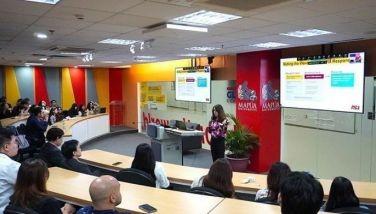Smart agriculture

Agriculture in tiny Taiwan, with its land area of nearly 36,200 square kilometers just over a tenth that of the Philippines, will make the P20-a-kilo rice administration drool with envy.
Taiwan is 100 percent sufficient in rice, with a six-month buffer.
Because of its commitments with the World Trade Organization, however, Taiwan still imports rice, adding to its surplus, which it uses to produce processed items such as rice wine, rice cakes and crackers.
Their rice variety is premium and pricey. Taiwan doesn’t export its rice, but it donates its surplus to friendly countries including the Philippines. Any rice stock that is not consumed within three years is used as animal feed.
Taiwanese agriculture defies the economies of scale. Visiting the Ministry of Agriculture in Taipei last week, I learned that the typical Taiwanese rice farmer has only about a hectare of land, while there are many small-scale producers of a wide variety of other agricultural items. But through innovative technology, smart agriculture practices and government support that goes beyond rhetoric, Taiwanese farm production is among the highest in the world.
Apart from having a rice surplus, Taiwan is 90 percent self-sufficient in fruits and vegetables, according to Lih-Fang Lin, director general of the ministry’s Department of International Affairs. Overall national food security is at 31 percent, close to Japan’s 38 percent.
Taiwan is a major producer of the moth orchid, and its tea is world-renowned. Alishan high mountain oolong is my favorite tea. Taiwanese garlic – large, with the taste inferior to our native Ilocos garlic, but at half the price – dominates Philippine markets. Many of those large, smooth, bright red and yellow onions you see in the market are also imported from Taiwan.
For Taiwan, which China has been moving to isolate from the world, food security is one of the top priorities, Lin told journalists who visited the ministry last week.
Under intense economic coercion tactics employed by China, Taiwan has been weaning itself away from the Chinese market, and strengthening partnerships with other countries. The Philippines should also brace for intensified economic coercion employed by Beijing.
Beyond disengaging economically from China and diversifying its markets and supply chains, Taiwan is boosting domestic farm and fisheries production, embracing technology including artificial intelligence and promoting climate resilience in agriculture.
* * *
With low population growth and fewer youths pursuing careers in agriculture, the Taiwanese government is incentivizing farming.
The government facilitates contract production to prevent crop wastage. Cold chain facilities have been in place for a long time, allowing farmers to grow crops such as the edamame legume and sell it frozen for both export and the domestic market.
Crop diversification is encouraged along with organic farming, which targets the high-end export market. Low-interest loans are provided to those engaged in agriculture. Elderly farmers are encouraged to re-lease their lands to younger ones.
Farmers of all ages are assisted in utilizing innovative technology, such as drones and smart net greenhouses. They are given assistance in understanding e-commerce to boost sales even as the government facilitates international marketing. For food safety, there is a system of tracing agricultural produce.
Under new President William Lai, Taiwan is pursuing a policy of “smart, resilient, sustainable and healthy” agriculture, according to a ministry official. You can be sure those words are not mere aspirations, like rice at P20 a kilo.
Other aspects of agriculture are also automated and climate-resilient. A fisheries monitoring center operates around the clock. Robotic devices are used for cattle feeding. Biogas – produced from cattle and hog manure – is harnessed for power generation, as part of carbon-neutral initiatives in agriculture.
There are demo farms that not only serve as models for farmers but are also tapped for agriculture tourism, revolving around the theme of sustainable harmony between humans and nature.
Taiwan calls it “agriculture for the future,” with food production seen as one of the island’s key links to the world.
* * *
I think of Taiwan’s agriculture following the launch this month of a project that aims to promote climate-resilient agriculture in the Philippines.
The “Adapting Philippine Agriculture to Climate Change” or APA Project is a joint undertaking of the Department of Agriculture, the UN Food and Agriculture Organization (FAO) and the Philippine Atmospheric, Geophysical and Astronomical Services Organization.
APA, with funding of $39.2 million including $26.3 million from the Green Climate Fund, aims to empower 1.25 million farmers in nine provinces identified as climate hotspots to develop sustainable agriculture practices using climate-resilient technologies.
The seven-year project, approved last year, is seen to indirectly benefit over five million Filipinos.
A statement from the FAO said APA will integrate training, market access, provision of production inputs and financing to boost food security, household incomes and resilience.
With the involvement of the FAO, perhaps the goals of this project will move beyond political rhetoric.
Jong-Jin Kim, the FAO regional representative for Asia and the Pacific, said in a video message: “With such huge targets and potential impact, I fervently hope that everyone
maintains a good level of commitment and passion in implementing this project.”
This is a big question mark. Maybe if national food security in the Philippines’ faced the same threats as in Taiwan, the FAO can be assured of that “good level of commitment and passion.”
For Taiwan, smart agriculture goes beyond aspiration.
- Latest
- Trending






















